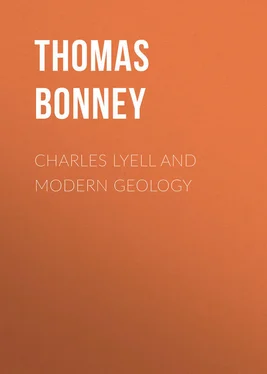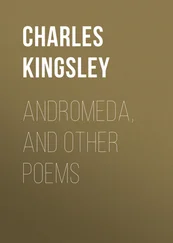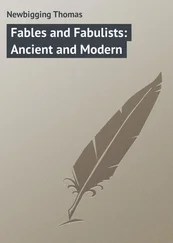Thomas Bonney - Charles Lyell and Modern Geology
Здесь есть возможность читать онлайн «Thomas Bonney - Charles Lyell and Modern Geology» — ознакомительный отрывок электронной книги совершенно бесплатно, а после прочтения отрывка купить полную версию. В некоторых случаях можно слушать аудио, скачать через торрент в формате fb2 и присутствует краткое содержание. ISBN: , Жанр: foreign_antique, foreign_prose, на английском языке. Описание произведения, (предисловие) а так же отзывы посетителей доступны на портале библиотеки ЛибКат.
- Название:Charles Lyell and Modern Geology
- Автор:
- Жанр:
- Год:неизвестен
- ISBN:http://www.gutenberg.org/ebooks/34502
- Рейтинг книги:5 / 5. Голосов: 1
-
Избранное:Добавить в избранное
- Отзывы:
-
Ваша оценка:
- 100
- 1
- 2
- 3
- 4
- 5
Charles Lyell and Modern Geology: краткое содержание, описание и аннотация
Предлагаем к чтению аннотацию, описание, краткое содержание или предисловие (зависит от того, что написал сам автор книги «Charles Lyell and Modern Geology»). Если вы не нашли необходимую информацию о книге — напишите в комментариях, мы постараемся отыскать её.
Charles Lyell and Modern Geology — читать онлайн ознакомительный отрывок
Ниже представлен текст книги, разбитый по страницам. Система сохранения места последней прочитанной страницы, позволяет с удобством читать онлайн бесплатно книгу «Charles Lyell and Modern Geology», без необходимости каждый раз заново искать на чём Вы остановились. Поставьте закладку, и сможете в любой момент перейти на страницу, на которой закончили чтение.
Интервал:
Закладка:
On his return, so far as can be inferred from the few letters which have been published, Lyell continued to work at geology, and at Christmas, 1821, was seeking in vain for freshwater fossils in the neighbourhood of Bartley. In the spring of 1822 he investigated the Sussex coast from Hastings to Dungeness, and studied the effects of the sea at Winchelsea and Rye. In the early summer of 1823 he visited the Isle of Wight, and in a letter to Dr. Mantell suggested that the "blue marl" 9 9 Now recognised as gault. The identification named above was soon found to be correct.
in Compton Chine is identical with that at Folkestone, and compared the underlying strata with those in Sussex, clearing up some confusions, into which earlier observers had fallen, about the Wealden and Lower Greensand. He was now evidently beginning to get a firm grip on the subject – a thing far from easy in days when so little had been ascertained – and this year he read his first papers to the Geological Society – one, in January, written in conjunction with Dr. Mantell, "On the Limestone and Clay of the Ironsand in Sussex"; the other in June, "On the Sections presented by Some Forfarshire Rivers." Also, on February 7th, he was elected one of the secretaries of that Society, an office which he retained till 1826. This is a pretty clear proof that he had begun to make his mark among geologists, and was well esteemed by the leaders of the science.
No sooner had he returned from the Isle of Wight than he started for Paris, going direct from London to Calais, in the Earl of Liverpool steam packet, "in 11 hours! 120 miles! engines 80 horse-power for 240 tons." In the last letter written to his father before quitting England he refers to our neighbours across the Channel in the following terms: "My opinion of the French people is that they are much too corrupt for a free government and much too enlightened for a despotic one." That was written full seventy years ago; perhaps even now, were he alive, he would not be disposed to withdraw the words.
At Paris he was well received by Cuvier, Humboldt, and other men of science, attended lectures at the Jardin du Roi, and saw a good deal of society. His letters home often contain interesting references to matters political and social – such as, for example, the following remarks which he heard from the mouth of Humboldt: "You cannot conceive how striking and ludicrous a feature it is in Parisian society at present that every other man one meets is either minister or ex-minister. So frequent have been the changes. The instant a new ministry is formed, a body of sappers and miners is organised. They work industriously night and day. At last the ministers find that they are supplanted by the very arts by which a few months ago they raised themselves to power." 10 10 Life, Letters, and Journals, vol. i. p. 127. Some sentences (for the sake of brevity) are omitted from the quotation.
Lyell more than once expresses a regret, which, indeed, was generally felt in scientific circles, that Cuvier had lost caste by "dabbling so much with the dirty pool of politics"; and himself works away at geology, studying the fossils of the Paris basin in the museums, and visiting the most noted sections in order to add to his own collection and observe the relations of the strata.
He returned to England towards the end of September, and no doubt spent the next few months in working at geology as far as his eyes, which were becoming stronger, permitted. The summer of 1824 was devoted to geological expeditions. In the earlier part he took Mons. Constant Prévost, one of the leaders of geology in France, to the west of England. Their special purpose was to examine the Jurassic rocks, but they extended their tour as far as Cornwall. Afterwards Lyell went to Scotland, where he was joined by Professor Buckland; and the two friends, after spending a few days in Ross-shire, went to Brora, and then returned from Inverness by the Caledonian canal. This gave them the opportunity of examining the famous "parallel roads" of Glenroy, which were the more interesting because they had already seen something of the kind near Cowl, in Ross-shire. Afterwards they went up Glen Spean and crossed the mountains to Blair Athol, visiting the noted locality in Glen Tilt, where Hutton made his famous discovery of veins of granite intrusive in the schists of that valley, and then they made their way to Edinburgh. Here much work was done, both among collections and in the field, and it was lightened – as might be expected in a place so hospitable – by social pleasures and friendly converse with some of the leading literary and scientific men.
Four years of comparative rest and frequent change of scene had produced such an improvement in the condition of his eyes that he was able to resume his study of the law, and was called to the Bar in 1825. For two years he went on the Western Circuit, having chambers in the Temple and getting a little business. But, as his correspondence shows, geology still held the first place in his affections, 11 11 He was also elected a Fellow of the Royal Society in 1826.
and papers were read to the Society from time to time. Among them one of the most important, though it was not printed in their journal, described a dyke of serpentine which cut through the Old Red Sandstone on the Kinnordy estate. 12 12 It appeared in the Edin. Journ. Sci. , iii. (1825) p. 112, being his first actual publication. Its importance consisted in proving that serpentine was, or rather had been, an igneous rock. If proper attention had been paid to it, fewer mistaken statements and hypotheses would have attained the dignity of appearing in print.
But, as is shown by a letter to his sister, written in the month of November, he had not lost his interest in entomology. At that time the collectors of insects in Scotland were very few in number, and the English lepidopterists welcomed the specimens which Lyell and his sister had caught in Forfarshire. The family had left Bartley Lodge in the earlier part of the year and had settled in the old home at Kinnordy. About this time also Lyell began to contribute to the Quarterly Review , writing articles on educational and scientific topics. This led to a friendship with Lockhart, who became editor at the end of 1825, and gave him an introduction to Sir Walter Scott. A Christmas visit to Cambridge introduced him to the social life of that university.
In the spring of 1827 his ideas as to his future work appear to have begun to assume a definite form. To Dr. Mantell 13 13 Dr. Gideon A. Mantell, a surgeon by profession, at that time resident in Lewes, who made valuable contributions to the geology of South-East England, and was also distinguished for his popular lectures and books. He died in 1852.
he writes that he has been reading Lamarck, and is not convinced by that author's theories of the development of species, "which would prove that men may have come from the ourang-outang," though he makes this admission: "After all, what changes a species may really undergo! How impossible will it be to distinguish and lay down a line, beyond which some of the so-called extinct species have never passed into recent ones!" The next sentence is significant: "That the earth is quite as old as he [Lamarck] supposes has long been my creed, and I will try before six months are over to convert the readers of the Quarterly to that heterodox opinion." 14 14 Probably referring to an article on Scrope's "Geology of Central France," in which he shows that he fully accepted the Huttonian doctrine of interpreting the geology of past ages by reference to the causes still at work. It appeared in the Quarterly Review , Oct. 1827, vol. xxxvi. p. 437.
A few lines further on come some sentences which indicate that the leading idea of the "Principles" was even then floating in his mind. "I am going to write in confirmation of ancient causes having been the same as modern, and to show that those plants and animals, which we know are becoming preserved now, are the same as were formerly." Hence, he proceeds to argue, it is not safe to infer that because the remains of certain classes of plants or animals are not found in particular strata, the creatures themselves did not then exist. "You see the drift of my argument," he continues; " ergo , mammalia existed when the oolite and coal, etc., were formed." 15 15 Life, Letters, and Journals, vol. i. p. 169.
The first of these quotations strikes the keynote of modern geology as opposed to the older notions of the science; what follows suggests a caution, to which Darwin afterwards drew more particular attention, though he turned the weapon against Lyell himself, viz. "the imperfection of the geological record."
Интервал:
Закладка:
Похожие книги на «Charles Lyell and Modern Geology»
Представляем Вашему вниманию похожие книги на «Charles Lyell and Modern Geology» списком для выбора. Мы отобрали схожую по названию и смыслу литературу в надежде предоставить читателям больше вариантов отыскать новые, интересные, ещё непрочитанные произведения.
Обсуждение, отзывы о книге «Charles Lyell and Modern Geology» и просто собственные мнения читателей. Оставьте ваши комментарии, напишите, что Вы думаете о произведении, его смысле или главных героях. Укажите что конкретно понравилось, а что нет, и почему Вы так считаете.












